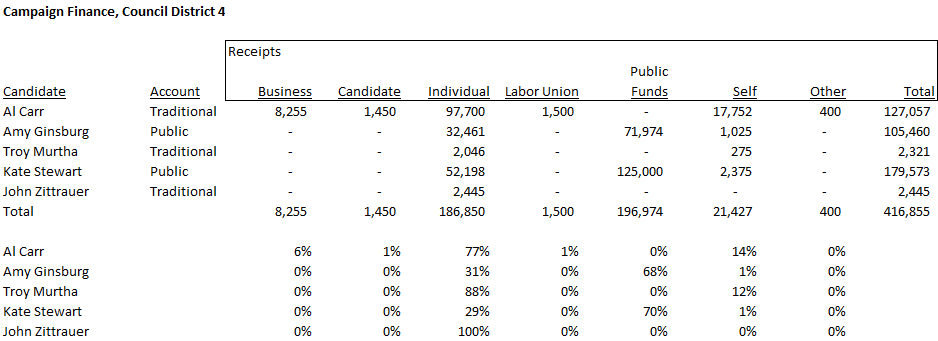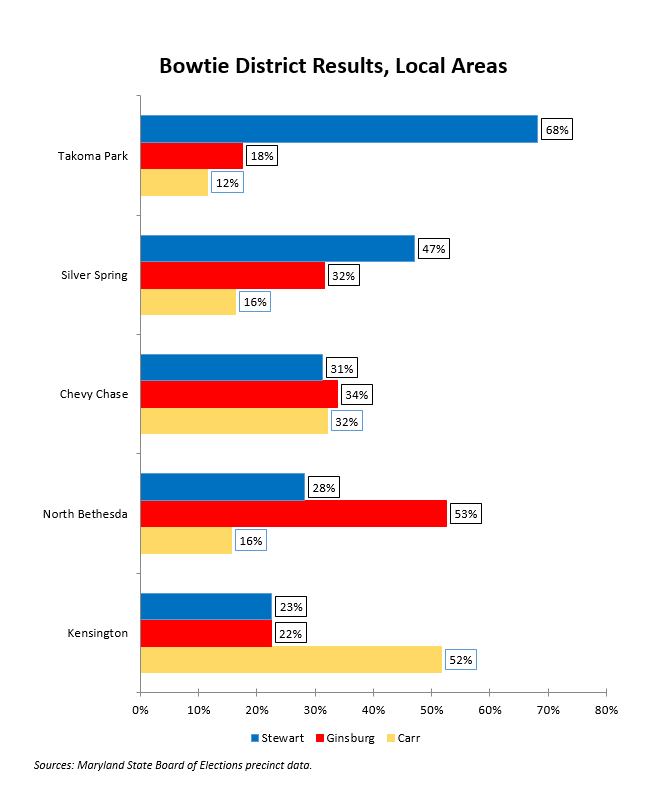By Adam Pagnucco.
Council District 4, known as “the Bowtie District,” had five candidates but only three were viable: Takoma Park Mayor Kate Stewart, Friends of White Flint Executive Director Amy Ginsburg and four-term District 18 Delegate Al Carr. Each candidate started with a base but only one would win.
First, let’s look at campaign finances.

Stewart and Ginsburg used public campaign financing, which distributes public matching funds through a formula tied to individual contributions from county residents. Stewart maxed out her matching funds, one of only three council district candidates to do so. (The other two were District 2’s Marilyn Balcombe and District 5’s Kristin Mink.) Ginsburg fell well short of maxing out. Carr’s fundraising for the cycle exceeded Ginsburg’s total by a bit but did not come close to Stewart.
Stewart got almost all of the important progressive endorsements, including but not limited to MCEA, SEIU Local 500, MCGEO, Casa in Action, Progressive Maryland, the career and volunteer fire fighters and more. This was incredibly useful in a council district in which most of the votes come from super-progressive places like Takoma Park and Downtown Silver Spring. Ginsburg’s best endorsement was the Washington Post. Carr was endorsed by Our Revolution, a group founded by U.S. Senator Bernie Sanders.
Stewart’s edges in money, endorsements and starting geography paid off. In the end, she received 43% of the vote, exceeding Ginsburg (33%) and Carr (20%). Here is how the three candidates did by local area. Stewart appears in blue, Ginsburg in red and Carr in yellow. (See my methodology post for definitions.)

None of this is terribly surprising. Stewart dominated Takoma Park and won Downtown Silver Spring by a lot. Carr won Kensington, Ginsburg won North Bethesda and the two Chevy Chase precincts were a three way split. But because Takoma Park and Downtown Silver Spring were a sizeable majority of the district, Stewart’s big wins in those two areas sealed the election in her favor.
Did Carr spoil the race for Ginsburg? That’s hard to say. In his absence, she may have been able to pick up some votes in Chevy Chase and Kensington, but there is no evidence that Ginsburg was more popular in those places than Stewart. Also, Stewart’s advantages in money, endorsements and geography would have held up regardless of what Carr did.
As for Carr, while he won 37% of the vote and first place inside District 18, he only received 13% of the vote outside it, trailing both Stewart (49% outside District 18) and Ginsburg (34%). Carr didn’t have enough time to build his votes outside his legislative district, especially against quality candidates like Stewart and Ginsburg. He should have thought of that before entering this race, especially since he had a safe delegate seat to lose.
The lopsided geography of the Bowtie District, where most of the votes come from the east side, raises the possibility that players in Kensington and North Bethesda will feel like the red headed stepchildren of Silver Spring and Takoma Park. Stewart needs to build a constituent service operation of sufficient quality to make sure that those areas do not feel left out. If she does not, they will become a thorn in her side as long as she represents the district even if they lack the power to defeat her.
